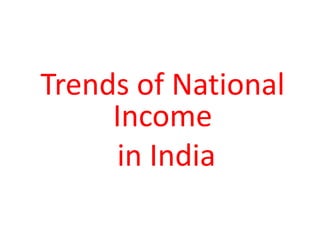
Trends in National Income in India.ppt
- 1. Trends of National Income in India
- 2. Trends of National Income ( Percent Per annum) : The Hindu Growth rate Period Target Actual First Plan (1951-56) 2.1 3.5 Second Plan (1956-61) 4.5 4.2 Third Plan (1961-66) 5.6 2.8 Fourth Plan (1966-75) 5.7 3.2 Fifth Plan (1974-79) 4.4 4.7 The target growth rate in first three plans was set with respect to National Income .In fourth Plan it was Net Domestic Product and thereafter it has been GDP( at factor cost) Actual Growth rates are in terms of National Income ( NNP at factor cost at 1999-200 Price )
- 3. Trends of National Income ( Percent Per annum) The Hindu Growth rate Period Target Actual Sixth Plan ((1980-85) 5.2 5.5 Seventh Plan (1985-90) 5.0 5.6 Eight Plan ( 1992-97) 5.6 6.5 Ninth Plan (1997-2002) 6.5 5.5 Tenth Plan (2002-07) 8.0 7.8 1951-1980 3.6 1981-1990 5.6 1992-2007 6.1 The target growth rate is at GDP( at factor cost) .Actual Growth rates are estimated in terms of National Income ( NNP at factor cost at 1999-200 Price )
- 4. Observation • The real national income of India has increased at an annual average rate of 4.0 percent. During this period, population has also increased at an average rate of 2 %. Thus, per capita income has increased only by 2% • The rate of growth initially decelerated over the years but has subsequently accelerated continuously. • Fluctuations in year-to-year growth rates in early stages were very marked, which indicated that economy had failed to create conditions conducive to stable economic growth. • An examination of the annual rates of change-observed by the three sectors of the economy, primary, secondary and the tertiary- further shows that the annual variations are not specific to any one sector.
- 5. National Product by Industry Origin Industry Group 1.Primary of which 21.3 Agriculture 19.5 Mining and quarrying 1.8 2.Secondary of which 22.2 Manufacturing Registered 8.6 Manufacturing unregistered 4.5 3..Tertiary of which 56.4 Transport and communication and Trade of which 28.0 Railway 1.1 Trade and Hotel 16.9 Finance and Real Estate of which 14.4 Financing and Insurance 7.3 Community and Personal Services of which 14.0 public administration and defense 5.5
- 6. The share of Primary sector was 75 percent in the first decade of twentieth century came down to 21.6 percent in 2006-07 Sub sector 1970-71 price At 1980-81 price At 1999- 2000 prices 1960-61 1970-71 1981-82 1991-92 2006-07 Agriculture and allied 54.4 47.4 36.5 29.4 19.5 Mining and Quarrying 0.9 0.9 1.4 1.5 1.8 Primary Sector 56.6 50.1 41.1. 33.2 21.3
- 7. Declining share of Agriculture Progress of stagnation • This decline is more because of rate of growth has been less than other sector. • The rate of agriculture growth has been less than the overall growth of the economy • Agriculture still is the single largest contributor is GDP
- 8. Deceleration in Agriculture Growth Rate of Growth of Agriculture 1951-52 to 2006-07 Period Total Econo my Agri. and Allied Crops and live stock Non agricul ture Pre Green Revolution 1951- 52 to 1967-68 3.7 2.5 2.7 4.9 Green revolution 1968-69 to 1980- 81 3.5 2.4 2.7 4.4 Wider technology Dissemination period 181-82 to -1990-91 5.4 3.5 3.7 6.4 Early Reform Period 1991-92 to 1996-97 5.7 3.7 3.7 6.6 1997-98 to 2006-07 6.6 2.5 2.5 7.9 Govt of India – Economic Survey 2007-08 table 7.1 1. The rate of growth of agriculture ( 1950-51 to 2006-07) about 2.7 percent is much less than other sectors, but on an average higher than the growth rate of population 2.1percent 2. The rate of growth of food grain production in 1990-2007 decelerated to 1.2 percent , lower than the growth rate of population 1.9 percent per annum
- 9. Structural Change in Manufacturing 1. The share of registered manufacturing over the period of time has grown and that of unregistered has declined . 2. Although the growth rate of industrial production has been less than stipulated in plan , but the industrial growth rate of impressive vis-à-vis agriculture
- 10. Other trends in Secondary sector • The growth of water – gas and electricity services has been quite less. • The share of construction has risen from 4 percent in 1950-51 to 6.2 percent and thereafter it increased to about 7.4 percent in the year 2005-6
- 11. Change in Tetriary sector 1. The tetriary sector has registered significant growth, as its share in GDP has gone up from one fourth to close to sixty percent 2. All the groups and sub groups of this sector have grown substantially 3. Among transport trade and communication the share of trade , hotel and restaurant has grown from 13 percent in 1960- 61 to 16.9 percent in 2006-07. The share of communication- IT enable services in to the GDP has gone up to 7 percent (2007-08)
- 12. Some Implication • Though these trends are in line with global trends, two features are distinctive to India.s services sector. First ; • The share of agriculture in GDP has declined by about 25 percentage points, while industry and services gained equally. • The share of industry has stabilized since 1990 and consequently, the entire subsequent decline in the share of agriculture in GDP has been picked up by the services sector. • This trend (rising share of services in GDP and corresponding)decline in the share of agriculture and manufacturing sector) is seen in the growth process of high-income countries and not in general in developing countries.